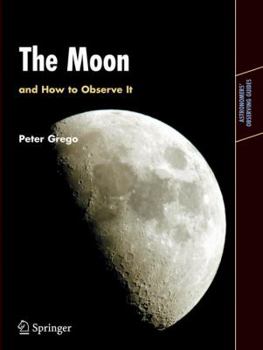The Moon and How to Observe It
(Part of the Astronomer's Observing Guides Series)
Select Format
Select Condition 
Book Overview
This revolutionary new book is written for practical amateur astronomers who not only want to observe, but want to know the details of exactly what they are looking at. The Moon is usually first astronomical object to be observed by amateur astronomers and this is the first book to deal equally with the Moon itself - its formation, geology, and history - as well as the practical aspects of observation. The concept of the book - and of all the Astronomers'...
Format:Paperback
Language:English
ISBN:1852337486
ISBN13:9781852337483
Release Date:October 2005
Publisher:Springer
Length:274 Pages
Weight:1.58 lbs.
Dimensions:0.7" x 7.5" x 9.2"
Customer Reviews
4 ratings
Good for observing, missing some useful info
Published by Thriftbooks.com User , 15 years ago
This book is a good, basic intro to observing the Moon. But it could have been so much better. Part I gives an intro to the Moon's structure, origins and -- for lack of a better term -- geology. However, the writer is clearly out of his element here, particularly in the discussion of the Moon's origin. He uses technical terms that are inaccurate -- the one point where he talks about some particular lunar lavas being "ductile" sticks in my mind. A co-author -- or a good, knowledgeable editor -- would help here. The discussions of libration and eclipses are adequate. Part II is where the book shines. A lot of time has obviously been spent at the eyepiece, viewing the Moon, and this section on observing really shows that. However, even here, we can get fairly pedantic; especially when the author credits himself for photographs, and continues to do so, over and over again. The book is really lacking in two things: 1) There are no data tables of any kind. Any introduction to a lunar coordinate system in the text, accompanied by a listing of major features and their locations in an appendix, would be very helpful. Just a table of features and days past new when they are best viewed would be a big improvement. 2) As far as this book is concerned, the far side of the Moon does not exist. I do understand that this is supposed to be an observing guide, and we can't look at it from Earth. But the book includes discussions of the moons of other planets, comets and asteroids, and other topics far less relevant. The fact that the far side doesn't even appear in the Index will tell you something about how much this is glossed over. As an amateur astronomer who is mainly a deep-sky observer, the Moon is mostly a target of my scorn. The Moon makes the sky too bright to see the faint objects that I normally look at. I bought this book because I thought it would give me a greater appreciation for something that is normally "just in the way." To some extent, it has helped; and for that I give it 4 stars. But if I had it to do over again, I would search for a better reference than this.
I'm Romantic about the Moon; but as an Amateur Astronomer I Love Moonless Nights!! Well; until I got
Published by Thriftbooks.com User , 15 years ago
No matter who you talk to, its always roughly a similar story, the first object to look at when you get your Telescope out of the box is the moon, its easy to find and quiet fascinating. Within few weeks or even days it becomes a nuisance when viewing other deep sky objects and planets; besides other light pollution and limitations. You look at the moon, you see craters and dark lava, all looks the same; one crater is like the other. It became more interesting when I got the Moon Maps and Moon Phase Maps and the Lunar 100 List to spice things up and most recently the LCROSS space mission and Apollo 11 40th anniversary which I witnessed at the age of 4 in 1969 to get me revive my interest in the moon. Then I purchased this book and the moon started taking on a whole new dimension. The Moon is fascinating and is full of history from its creation to the most recent events those natural and man made. I'm no longer looking at Craters, Faults, and Edges and Rimae the same any more but rather I see what I did not see before. This book is your Moon Polarizer Filter; it brings things into Focus and makes you appreciate that Shinny Object that was once "Theoretically" a part of our planet Earth. The lunar features have a story to tell and this book helps you understand their language. Happy Moon Lighting!!! [...]
lacks coordinates
Published by Thriftbooks.com User , 16 years ago
I agree with previous reviewer. It is a nice book with a lot of nice photographs easy to read for a new comer. But the absence of coordinates for the described lunar features makes difficult the connection with a detailed lunar atlas such as found at lunar and Planetary Institute http://www.lpi.usra.edu/ or published by the National Geographic Society. Most photographs are oriented south up north down and other in the reverse direction. You have to find out.
Great Moon Guide
Published by Thriftbooks.com User , 16 years ago
For those amateur astronomers or any interested in the Moon, this is the book for you. Its lack of jargon only professional use is its obvious selling point, but also its get plenty of information use for amateur observation of the Moon.






